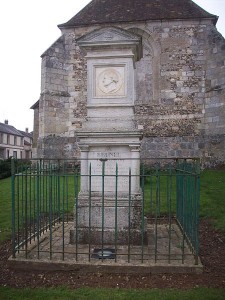Chapter ToC – Next >
Birth of Mr. Brunel, April 9, 1806 – Sir Marc Isambard Brunel – The Block Machinery
Isambard Kingdom Brunel was born on the ninth day of April, 1806, at Portsmouth, and was the only son of Sir Marc Isambard Brunel. [1]
Most biographies commence with an account of the parentage of the person whose life is about to be written. If this be permitted in any case, no apology can be needed for prefixing to a Life of Mr. Brunel some particulars of his father’s career, since he was indebted to him, not only for the inheritance of many natural gifts, and for a professional education such as few have been able to procure, but also for a bright example of the cultivation of those habits of forethought and perseverance, which alone can ensure the successful accomplishment of great designs.

Sir Marc Isambard Brunel was a native of Hacqueville, a village in Normandy, where his family had been settled for several generations. He was originally intended for the priesthood; but, as he showed no inclination for that calling, and a very decided talent for mechanical pursuits, he was permitted to enter the French Navy; and he served in the West Indies for six years, namely, from 1786 to 1792. On his return home, at the expiration of his term of service, his strong Royalist sympathies made it unsafe for him to remain in France, and with great difficulty he managed to escape to America. He landed at New York in September 1793, and soon obtained employment as a civil engineer. A few years afterwards he was appointed engineer to the State of New York; and, while holding that office, he designed a cannon foundry and other important public works.
In January 1799, when Sir Isambard was in his thirtieth year, he came over to England, and shortly after his arrival married Miss Sophia Kingdom, a lady for whom he had formed an attachment some years before. [2]
The first great work undertaken by him in this country was the machinery for making blocks, which he designed and erected for Government at Portsmouth.
The history of the invention and construction of this system of machinery (for it consisted of forty-three separate machines) need not be given at length; but it may be permitted to extract the following passage from Mr. Beamish‘s ‘Life of Sir Isambard Brunel‘ (pp. 97, 99, 2nd edition), in which, he points out the benefits which have resulted from its introduction, and the position its inventor is entitled to hold among those who have contributed to the progress of mechanical science.
Where fifty men were necessary to complete the shells of blocks previous to the erection of Brunel’s machinery, four men only are now required, and to prepare the sheaves, six men can now do the work which formerly demanded the labours of sixty. So that ten men, by the aid of this machinery, can accomplish with uniformity, celerity, and ease, what formerly required the uncertain labour of one hundred and ten.
When we call to mind that at the time these works were executed, mechanical engineering was only in its infancy, we are filled with amazement at the sagacity and skill that should have so far anticipated the progress of the age, as to leave scarcely any room, during half a century, for the introduction of any improvement. . . .
Beautiful as are the combinations and contrivances in the block machinery, and highly deserving as the inventor may be of credit for originating such labour-saving machines for the production of ships’ blocks, there is a far higher claim to the admiration and gratitude of all constructors of machinery, and of all workers in metal. In this block machinery exist the types and examples of all the modern self-acting tools, without the aid of which the various mechanical appliances of the present day could not be produced with the marvellous accuracy which has been attained. It is true that to the trades unions or combinations among the artisans, is in a great measure directly due the introduction of self-acting machines; but the types of all these tools existed in the machines and combinations of Brunel’s block machinery. The drilling, the slotting, and the shaping machines, the eccentric chuck, and the slide rest, with the worm wheel motion, are all to be found in his machine.
On the completion of the block machinery Sir Isambard Brunel removed to London, and took a house in Lindsay Row, Chelsea, where he remained until he was obliged to live nearer the works of the Thames Tunnel.
[1] To avoid confusion, Sir Isambard Brunel has been called throughout by that designation, the one by which he is generally known: he was knighted on March 24, 1841. His Life has been written by Mr. Richard Beamish, F.R.S. (London, 1862.) [2] Lady Brunel survived her husband five years. Of their children, three lived to maturity, one son, Isambard Kingdom, and two daughters, Sophia, wife of the late Sir Benjamin Hawes, KCB, Under Secretary of State for War, and Emma, wife of the Rev. George Harrison, Rector of Sutcombe.
Chapter ToC – Next >